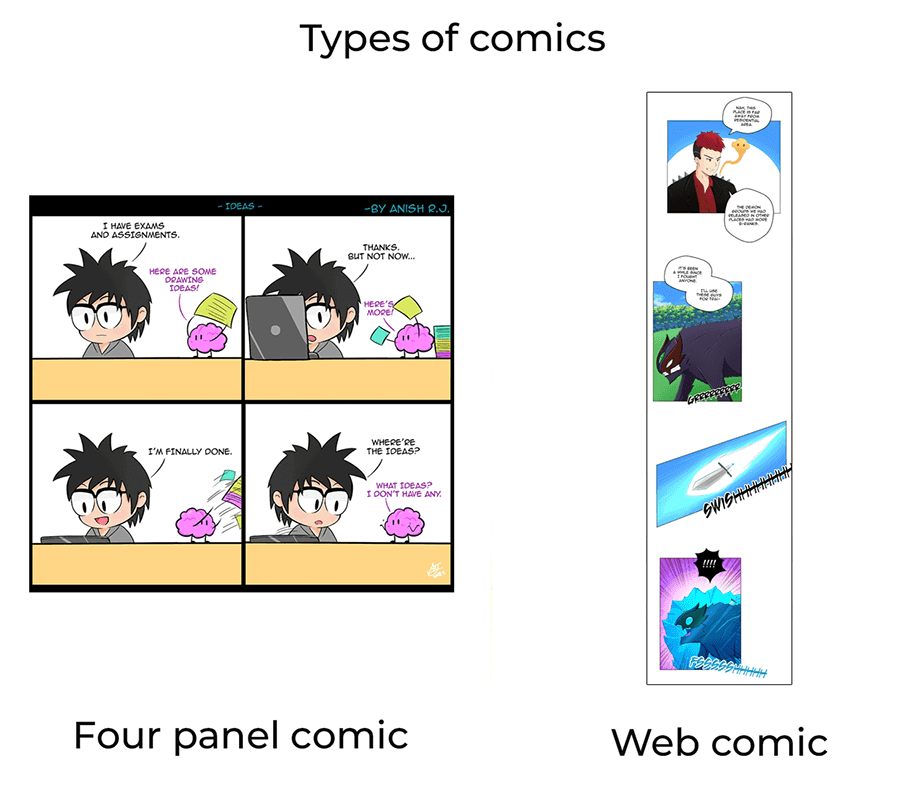Let us start with the question. What are comics? What do you consider to be a comic? You may have read them when you were a child, or you may have seen them in newspapers or magazines.
Maybe you haven't even seen a newspaper or magazine in this time and age. Even if you have never read comics, you may have seen media inspired by comics like Marvel's Avengers, Batman, The Walking Dead, One Piece, Demon Slayer, etc.
What Are Comics?
Comics are a medium that uses images in a sequence (that may include words) to tell a story and express ideas.
Comic means to cause laughter. Comic strips and books started out with a reason to cause laughter and joy. But comics changed and evolved as time went by. Comic books can now tell a story of any genre to evoke feelings like happiness, sadness, excitement, motivation, anger, content and more. They have evolved into graphic novels to tell a longer story with many characters.
Comics are made in almost every country in some form. Japan's form of comic books, mangas as Dragonball, One Piece and Naruto, have been famous worldwide because of their rich story, characters and artwork.
I am not, by any means, a professional comic book artist, but I have made a few, including a published book, Daemon Ignition(2016) and a current ongoing webcomic. By making those comics, I learned a few things, tips and mistakes, which I wish to share in this series of articles.
I have also been inspired by manga and comic books like Spider-man, Batman, Archie, Asterisk and Tinkle during my childhood. It made me want to pick up a pencil and paper and scribble anything that came to my mind. Why? Because it was fun, I wanted to try to emulate the same feelings I had received while reading others' works.
Why Make Comics?
So why make comics? If the reasons I have mentioned above have not been enough, let me explain more. It is a form of expression through which you can share your stories in both written and visual forms.
There are many platforms to publish the comic online – Webtoon, Tapas, or you can upload it on your own website. The comic publishing websites with an existing audience will be easier to garner the public eye. If you already have an audience for your work, your own website might be viable as well.
You can earn some money depending on your viewers, advertisements and sales.
Types

There are different types of drawing comics.
Four-panel comics are short comics with only four images to tell a short story. You may have seen them in your newspapers (if you remember them), or more recently, you may have seen them on social media websites like Instagram or Facebook. They may have stories or events that end in a single chapter.
Graphic novels or comic books are longer forms of comic books where their stories continue for several chapters.
Webcomics are different from physical comic books because of their vertical scrolling format, mainly made for digital viewing on mobile devices. They have both short four-panel web comics and longer episode-based chapters. Webcomics have been becoming famous due to the high use of mobile devices and frequent uploads (weekly or bimonthly).
How to Make Comics
Comics require a collaboration of multiple skills or multiple people. To create comics, you must write a story, draw the pictures, colour them and type the dialogues.
Comic companies like Marvel and DC usually hire a team of artists where one person called the writer writes the story, the penciller draws the sketch, another person inks on top of the sketch, the colourist colours the inked drawings, the letterer types dialogues and narration text, and the editor edits and gives feedback.
You can make a comic book yourself if you can do all these. This will take time and dedication, but you will have full creative control over your creations.
There are no hard and fast rules to comic creation. The choices of comic theory from Scott McCloud's "Clarity" diagram in the book Making Comics can be useful for learning how to communicate with the audience clearly.
- Moment - While making comics, the choice of scenes you show is important. You can only show one panel to describe a moment or multiple panels. Cutting or adding a single panel can affect how the story is read.
- Frame - Frame is the layout and bounding box to share the story. This is the window to show the readers what they need to see. Zooming in can make the readers focus on the specific details you want to show, whereas a wide shot of a city can give them a sense of the world in which your story is taking place.
- Image - These are the drawing, pictures or illustrations that separates a comic book from a novel. Your style of drawing characters, environment and choice of colours affect how your comic will be experienced by the readers.
- Word - The text for dialogue sharing the story also plays an important role. There are comics or scenes where words are unnecessary, but when they are used, they can heavily affect the overall comic. If you make a horror or thriller comic, but the dialogues are silly and funny, it will affect the reader's experience.
- Flow - The mix of all the above elements guides the readers from the start to the end of your story. Proper arrangement of the panels and elements will make it easier for your audience on which area to look at and focus on next.
In the next article, I will explain the steps in creating comics.
Thank you so much for reading the article. Hope you found it helpful. Consider subscribing and leaving a comment.
